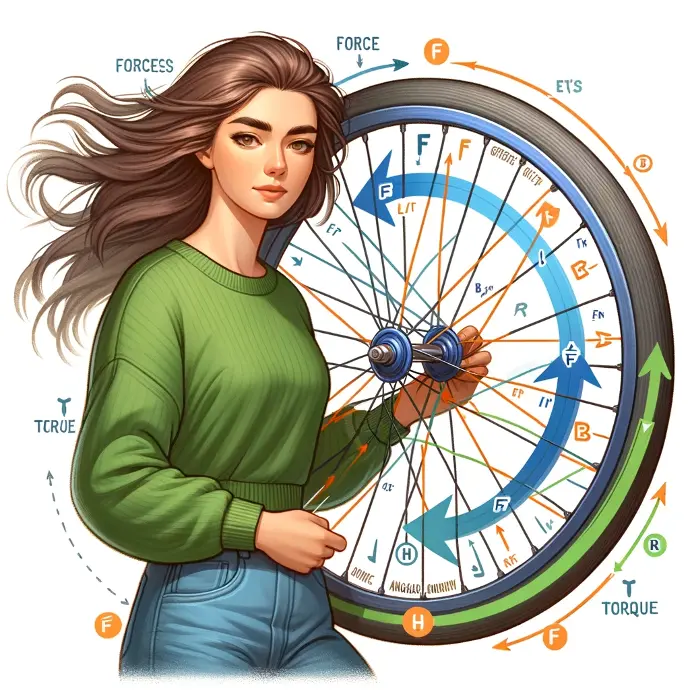
More than magic
This technology employs mechanical gyroscopes (flywheel) to store and release lateral forces, effectively stabilizing the vehicle during steering maneuvers. By integrating the driver's steering with the gyroscope's steering, lateral forces can be applied regardless of the vehicle's travel speed (even at very low speeds) or the level of traction on the ground (such as on ice or sand).
When the vehicle is falling on one side, the precession from the flywheel can passively augment the stability by steering the trajectory with the driver in the direction of the fall. This counteract the imbalance with centrifugal forces and precession forces away from the fall.
To further enhance stability in challenging conditions such as slippery surfaces or low speeds, the gyroscope is actively steered with the assistance of a power steering system that takes into account the driver's commands and input from various sensors. This innovative approach enables the application of precise lateral forces, regardless of traction levels, vehicle speed, or driver reflexes. This remarkable advantage ensures that the driver benefits from an additional balancing force and swift assistance, significantly reducing the probability of injuries or fatalities resulting from falls or rollovers.
Shaping our future
Enhancing vehicle stability encompasses more than just enhancing safety measures. It holds the transformative power to reshape the mobility landscape by propelling previous solutions to unparalleled heights. While the concepts of aerodynamic, safe, electric, and small vehicles are not novel, it is the holistic integration of these advantages that will constitute a genuine paradigm shift.
InerSci's cutting-edge self-balancing technology has revolutionized the design landscape of cabin motorcycles and velomobiles. Eliminating the need for riders to place their foot on the ground when coming to a stop streamlines the design process of adding a fairing around the vehicle, therefore enhancing safety, performances and convenience.

More efficiency
The balancing of narrow vehicle enable the use of a body (fairing) to make the vehicle much more energy efficient. Energy loss thru air resistance usually constitute around 90% of the energy used on bicycle and reducing it dramatically increase the range.
The flywheel used to balance the vehicle can also be used as a Kinetic Energy Recovery System (KERS). With cars, it's around 60% of the energy that goes into fighting the inertia and this energy can be mostly recovered when a KERS is used.
See the comparison below.
More performance
More efficiency mean the same power can go faster and farther since the energy is used to accelerate and is recovered when braking instead of being loss in friction.
Referring to the chart below, cabin motorcycle and velomobile can travel 30 time more distance than an electric car with the same amount of energy and the same battery. This provide incredible range even with an affordable battery.
It also mean you can travel 5 time faster with the same power. This mean the power from an E-bike is enough to reach highway speed.
More convenience
The integration of a fairing onto these vehicles not only enhances their overall aesthetics but also provides a heightened level of comfort. Acting as a protective shield, the fairing effectively shields riders from the elements, including wind, rain, and extreme temperatures.
Moreover, the fairing offers an additional layer of security by safeguarding against direct collisions, unauthorized access, and potential theft. This car-like experience ensures a secure and enjoyable ride, instilling confidence in riders as they navigate their journeys.
Energy required for Small vehicle
Enclosed vehicles, such as those with an added fairing, have the advantage of delivering impressive range even with a small battery. This may seem counterintuitive, but the added weight of the body is offset by the increased efficiency, as most of the energy lost to overcome air resistance (which accounts for around 90% of the resistance) in regular bicycles and motorcycles is saved with this approach. To illustrate this, refer to the graph comparing different modes of transportation, with the enclosed motorcycle shown at the top.

Price Matter
When comparing the manufacturing costs of bicycles, motorcycles, and scooters to cars, it becomes evident that the former are significantly more cost-effective, even with the inclusion of a body, fairing, or cabin. This heightened cost-efficiency renders them a financially viable alternative for individuals in pursuit of efficient and affordable modes of transportation. By facilitating accessible, eco-friendly, and efficient transportation, we ensure the availability of a sustainable solution that surpasses other alternatives.


